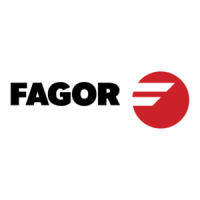CNC 8055
CNC 8055i
·M· & ·EN· MODELS
SOFT: V02.2X
13
·337·
HIGH-LEVEL LANGUAGE
PROGRAMMING
13.1 Lexical description
All the words that make up the high-level language of the numerical control must be written in capital
letters except for associated texts which may be written in upper and lower case letters.
The following elements are available for high-level programming:
• Reserved words.
• Numerical constants.
•Symbols.
Reserved words
Reserved words are those that the CNC uses in high-level programming for naming system
variables, operators, control instructions, etc.
All the letters of the alphabet A-Z are also reserved words, as they can make up a high-level language
word when used alone.
Numerical constants
Blocks programmed in high-level language admit numbers in decimal format and in hexadecimal
format.
• The numbers in decimal format must not exceed the ±6.5 format (6 digits to the left of the decimal
point and 5 decimals).
• The numbers in hexadecimal format must be preceded by the $ symbol and they must not have
more than 8 digits.
A constant higher than the format ±6,5 must be assigned to a variable by means of arithmetic
parameters by means of arithmetic expressions or by means of constants in hexadecimal format.
If the CNC operates in the metric system (millimeters), the resolution is a tenth of a micron and the
figures will be programmed in the ±5.4 format (positive or negative with 5 digits to the left of the
decimal point and 4 decimals).
If the CNC operates in inches, the resolution is a hundred-thousandths of an inch (ten millionths
of an inch) and the figures will be programmed in the ±4.5 format (positive or negative with 4 digits
to the left of the decimal point and 5 decimals).
For the convenience of the programmer, this control always allows the format ±5.5 (positive or
negative, with 5 integers and 5 decimals), adjusting each number appropriately to the working units
every time they are used.
To assign the value 100000000 to the variable "TIMER", It can be done in one of the following
ways:
(TIMER = $5F5E100)
(TIMER = 10000 * 10000)
(P100 = 10000 * 10000)
(TIMER = P100)

